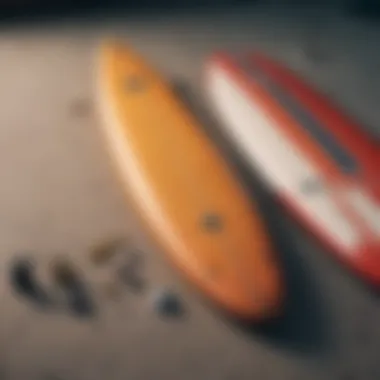Top Surfboards for Beginners: A Comprehensive Guide


Intro
Surfing is not just a sport; it's a lifestyle. For beginners eager to catch their first wave, choosing the right surfboard can feel like finding a needle in a haystack. With so many options available, it's essential to understand what makes a surfboard ideal for a novice. In this guide, we'll explore the best surfboards for learning, considering factors such as design, size, materials, and specific features that aid in the learning process.
This article will break down various aspects of surfboarding techniques, maintenance, and gear for beginners. As we delve into the intricacies of surfing, our primary focus will remain on how to help novice surfers make informed choices that will not only improve their skills but also enrich their overall experience on the water.
"The ocean stirs the heart, inspires the imagination, and brings eternal joy to the soul." – Wyland
In examining the world of surfboards, we’ll dissect the different types suitable for beginners, what they should be watching out for, and even how to gear up for the best surfing experience possible. Let’s jump into it and become well-acquainted with the pathways that lead to a successful start in surfing.
Understanding Surfboard Basics
Before you paddle out into the waves, it’s crucial to grasp the fundamentals of surfboards. Understanding surfboard basics goes beyond mere aesthetics or brand names; it’s about recognizing how a board’s design and construction can affect your surfing experience. From learning how to balance to mastering turns, the right board plays a pivotal role in your surfing progression. For beginners, this knowledge can separate a rewarding experience from one of frustration.
What Makes a Surfboard
A surfboard might look simple at first glance, but it’s a blend of art and engineering. At its core, a surfboard allows surfers to ride waves but how it performs can vary significantly. It primarily consists of a foam core wrapped in resin and fiberglass. The shape of the board—the length, width, and fin setup—impacts speed, maneuverability, and stability.
- Foam Core: Most boards use expanded polystyrene or polyurethane foam. It provides buoyancy and is crucial for stability, especially for novices still learning to balance.
- Fiberglass: This material provides strength and durability, ensuring the board can withstand impacts and the powerful forces of the ocean.
- Shape: The board’s outline and rocker (the curve of the board from nose to tail) influence the ride.
In brief, what makes a surfboard is its thoughtful construction, tailored to enhance the surfer's experience on the water.
Key Elements of Surfboard Design
When diving deeper into surfboard design, you encounter a few essential elements that influence performance:
- Volume: Refers to how much space the board displaces in water. More volume usually translates to increased stability, which can help beginners catch waves more easily.
- Tail Shape: Different tail shapes affect the responsiveness and control of the board. Squash tails, for instance, are versatile and suit various conditions, while pintails can help with smooth turns in bigger surf.
- Fin Configuration: The setup (single fin, thruster, quad, etc.) greatly influences how a board engages with waves. A thruster setup, with three fins, often offers a balance of drive and maneuverability, great for new surfers learning the ropes.
Ultimately, understanding these key design elements helps surfers make educated choices that align with their skill levels and wave conditions.
Common Surfboard Materials
Understanding the materials is nearly equally important as the design elements. Common surfboard materials shape how the board performs and holds up over time. Here are the most prevalent types:
- Epoxy: Lighter and stronger than traditional fiberglass, epoxy boards are more buoyant, which can help beginners paddle more easily.
- Polyester: This is the standard for many boards. It offers a traditional feel but can be less durable than epoxy.
- Soft-tops: Made from foam, these boards are forgiving and ideal for beginners. They reduce the risk of injury and minimize damage during falls.
Investing time in understanding surfboard materials leads to informed choices that suit your surfing style and needs, ensuring a smoother learning curve.
"A solid grasp of surfboard basics is your ticket to enjoying the waves and developing your skills faster—don't overlook it!"
Types of Surfboards for Beginners
In the world of surfing, the type of surfboard you choose can make a significant difference in your learning experience. For those just dipping their toes into the ocean, understanding the various kinds of surfboards can feel overwhelming at first. However, it's vital to recognize that different boards serve distinct purposes and cater to individual skill levels and needs. Embracing the right board can streamline your learning process, enhance your confidence, and ultimately contribute to a more enjoyable time on the waves.
Longboards
Longboards are often considered the ideal starting point for beginners. Their extended length, usually ranging from eight to twelve feet, provides greater stability while paddling and riding waves. This makes it easier for novice surfers to catch smaller waves and balance themselves while practicing.
Another benefit is that longboards typically have a rounded nose, which aids in buoyancy and prevents them from nose-diving when encountering waves. This feature, combined with their wider width, allows for smoother rides and a more forgiving experience.
Pros of Longboards:
- Stability: Easier to balance on while learning the ropes.
- Catch Waves: Better suited for smaller, slower waves.
- Paddling Ease: Larger surface area makes paddling to catch waves simpler.
One potential downside is that maneuverability can sometimes feel limited compared to shorter boards, but this can be a non-issue for new surfers who are still grasping the basics of surfing.
Soft-top Boards


Soft-top boards are another favorite for beginners. As the name suggests, these boards feature a soft polyurethane foam surface, making them safer to ride. This is essential for learners, as it minimizes the chances of injury during falls or collisions.
Soft-tops come in various shapes and sizes, offering the versatility needed for different surfing conditions. They tend to be lightweight, which can make them easier to handle in and out of the water. Additionally, their relatively lower price point makes them an appealing option for those just starting out.
Advantages of Soft-top Boards:
- Safety First: Soft surface reduces risk of injury.
- Budget-Friendly: Often less expensive than traditional boards.
- Light and Manoeuvrable: Easy to carry and control on waves.
However, they might not provide the same level of performance as hard-top boards for experienced surfers, which is a consideration for those looking to progress quickly.
Funboards
A funboard strikes a balance between longboards and shortboards, typically measuring between seven to nine feet in length. This type of surfboard combines the beneficial features of both styles, making it suitable for novice surfers eager to learn while also keeping maneuverability in mind.
The design of funboards usually includes a wider nose and tail than traditional shortboards, which aids in stability. Learners can enjoy the fun experience of catching waves while having the flexibility to practice turning and maneuvering with more advanced techniques.
Benefits of Funboards:
- Versatile Design: Works well in various wave conditions.
- Stable Yet Agile: Good for transitioning from beginner to more advanced skills.
- Enjoyable Experience: Offers a pleasant balance for learners.
Though they require a bit more skill than a longboard or soft-top, many find funboards to be a delightful way to step up their surfing game.
Shortboards
Shortboards are generally aimed at those who have already picked up some skills and are ready to tackle more challenging conditions. Measuring approximately five to seven feet in length, these boards allow for aggressive turns and fast maneuvers, making them a staple for performance surfing.
However, their reduced size can make balancing more challenging for newcomers. While a shortboard isn’t usually recommended for the absolute beginner, it might cater to someone who has a modest level of confidence and is willing to accept the steep learning curve that comes with these boards.
Key Points of Shortboards:
- Maneuverability: Great for executing sharp turns and tricks.
- Performance: Allows for a more dynamic surfing experience.
- Skill Development: Pushes new surfers to refine their balance and control.
Selecting the Right Surfboard
Choosing the right surfboard can make the difference between a delightful day on the waves and a frustrating struggle in the water. This section explores some vital elements to consider when selecting a surfboard, focusing on key aspects that are particularly relevant for beginners who are navigating their journey into the world of surfing. Getting it right from the start not only enhances the learning experience but can significantly accelerate skill development.
Importance of Size and Volume
When it comes to surfboards, size and volume play a critical role in a surfer's performance and comfort. Generally speaking, a larger board offers more stability, which is essential for novices still finding their footing. The volume of a surfboard—calculated in liters—indicates how much buoyancy the board possesses. A board with a higher volume floats more, helping inexperienced surfers catch waves more easily.
For beginners, a voluminous board not only aids in paddling but also provides a more forgiving platform when catching waves. This stability can boost confidence, allowing new surfers to focus on mastering the basics without feeling overwhelmed by balance issues. Remember, it’s not just about the size; it’s about how it feels under you. Each surfer's physical attributes—like weight and height—can influence the ideal board specs.
"Let the board be like a friend; it should support you, not push you to the edge."
Personal Skill Level Considerations
Your skill level is another crucial factor in surfboard selection. A beginner should choose a board that complements their current abilities while also offering room for growth. If one has just started, boards like longboards or soft-tops can be particularly forgiving, providing additional surface area to balance on.
As skills improve, surfers might look to shift to shorter boards that allow for more maneuverability and advanced techniques. It's essential to be honest about your level; attempting to master surfing with a board that's too advanced can lead to frustration and potentially, safety risks. Each surf outing should feel like a progression, not a battle against the board.
Identifying Suitable Conditions
It's not just about the surfer; the conditions play an important part too. Different surfboards perform better in various environments. Beginners typically thrive in smaller, cleaner waves. Choosing a surfboard suitable for these conditions enhances the learning process and provides a safer environment to practice.
The surf conditions encompass factors like wave size, tide, and wind. Novice surfers should avoid the temperamental pounding of heavy surf until they’ve gained some confidence. Getting familiar with local spots and understanding when and where to surf can help in making the right choice.
In summary, selecting the appropriate surfboard is a multifaceted process that encompasses size and volume, skill level, and surfing conditions. Surfing should be an enjoyable pursuit and understanding these elements can turn a novice’s struggle into a stylish glide on the waves.
Additional Factors to Consider


When you're knee-deep in the world of surfing, it's easy to get lost in the excitement of picking out a board and hitting the waves. However, understanding a few additional factors can make all the difference in your surfing experience. These considerations often get overshadowed by flashy graphics or brand names, but they play a crucial role in ensuring you get the best out of your investment.
Budgeting for a Surfboard
Time and again, surfers find themselves grappling with the price tag of a surfboard. Let’s get one thing straight: surfing can be as expensive or budget-friendly as you want it to be. It’s vital to set a budget before starting your hunt for the perfect board. Think of it like shopping for a car; a flashy model might catch your eye, but if it strains your wallet, you may want to reconsider.
- Entry-level boards often fall into the $300 to $800 range, making them a solid choice for learners.
- Mid-level boards, usually priced between $800 and $1,500, tend to offer better performance without breaking the bank.
- For seasoned surfers, high-end boards might climb well over $1,500.
Consider also the long-term cost. A more durable board may require a higher initial investment but can save you money down the road by lasting longer and requiring less repair.
Storage and Maintenance Needs
You might think surfing is just about catching waves, but there's a fair bit of care that goes into keeping your surfboard in shape. After spending your hard-earned cash, you’ll want to ensure it doesn't end up damaged or worn out. The first step is proper storage.
- Store your board upright or on a rack; don’t lean it against walls or other objects that might dent or scratch it.
- Ensure your board is out of direct sunlight and extreme heat, which can warp the material over time.
Maintenance is also vital. Rinse your board with fresh water after each session to remove salt and sand. Check for dings and repairs regularly, as small chips can grow into larger issues if left unattended. Keeping wax fresh is also crucial; apply it when it starts to feel slick underfoot.
Choosing a Brand
When it comes to brands, it often feels like diving into an ocean of options. Not all brands are created equal, and it’s essential to choose one that resonates with your skill level and aspirations.
Research is key here. Consider brands known for their durability and innovation. Some popular options include Channel Islands, Firewire, and Lost. Also, pay attention to customer reviews, as these can provide insights not just about the board but also about the company’s customer service.
- Brand Reputation: An established brand often ensures quality. However, don’t underestimate emerging brands that might be offering high-quality boards at competitive prices.
- Warranty and Customer Support: Check if the brand offers a warranty or replacement policy. This assurance can save you money and hassle if something goes wrong.
Ultimately, the right choice of brand can enhance your overall surfing experience, making you feel more connected to the sport as you learn and progress.
"A well-informed surfer is usually a happy surfer. Don’t rush into purchasing a board; take your time to research and understand your needs."
These factors are not mere trifles; they carry weight as you navigate your surfboard journey. Keep them in mind as you start your surfing adventure, and you'll be better equipped to enjoy every ride on the waves.
Surfboard Recommendations
Choosing a surfboard is a pivotal element in a beginner's surfing journey. A well-chosen board can significantly enhance the learning experience, allowing novices to make the most of their time in the water. With the right recommendations, both in terms of performance and comfort, beginners can find themselves catching waves and progressing quicker than ever before. This section lays out various categories of boards suitable for those just starting out, each tailored to unique learning styles and environmental conditions.
Top Longboards for Beginners
Longboards serve as an excellent introduction to surfing due to their stability and ease of paddling. They are often wider and longer than other boards, which offers a more forgiving platform. For those who are finding their sea legs, the extra length allows for a more controlled balance.
A couple of standout options include:
- Surftech Soft Top Longboard: This board offers a soft top that makes it easier to avoid injuries in case of wipeouts. It’s user-friendly and lightweight, perfect for learners.
- Wavestorm 8’ Soft Top: This board is widely praised for its affordability and durability. It’s a crowd favorite for a reason: it provides a lot of fun while safely navigating waves.
Each of these longboards serves the purpose of helping new surfers feel secure as they practice their paddling and balancing skills.
Best Soft-top Boards
Soft-top surfboards have solidified a reputation as ideal choices for beginners. Their cushioned tops reduce the risks of injury and allow even the most timid surfers to feel more at home in the water. Beyond safety, soft-tops are often more buoyant, facilitating ease of paddling.
Recommended options include:
- Catch Surf Odysea Log: This board is crafted with a blend of fun and practicality. It's wider design encourages beginners to catch waves more easily.
- BIC Sport 7’6” Soft Top: Known for its durability, this board can take a beating while providing the ideal support for learners getting used to the surf.
These boards can be found in local surf shops and online, making them accessible and practical for those just entering the surfing world.
Ideal Funboards for Learning


Funboards, blending the characteristics of both longboards and shortboards, offer a balance that suits many learning surfers. They enable beginners to experiment with different techniques without being limited by the board’s performance.
Some choices in this category are:
- NSP Funboard: This board is incredibly lightweight and maneuverable, ideal for testing waters while also allowing for quicker direction changes.
- Torq Mod Funboard: Featuring a slick design, this board is optimal for riding small to medium waves. It delivers a mix of stability and performance.
These boards create a comfortable environment to explore the nuances of riding different types of waves.
Recommended Shortboards for New Surfers
While shortboards are typically aimed at more experienced surfers, there are some designs which are beginner-friendly, particularly for those who feel confident and ready to challenge themselves.
Notable shortboards for novices include:
- Lost Mayhem Puddle Jumper: This board features a wider outline, making it surprisingly stable for a shortboard. It allows newcomers to transition into shortboard use smoothly.
- Firewire Dominator: Known for its versatility, many believe it’s one of the best entry-level shortboards allowing learners to ride well in varied conditions.
Shortboards demand a bit of skill, but for those driven to improve quickly, selecting the right model can make all the difference.
Remember, selecting your first surfboard is like finding the right pair of shoes; comfort and fit are key to enhancing your overall experience. It is crucial to feel at ease and confident as you take those first strides on the waves.
In summary, while the range of surfboards available can feel overwhelming, assessing personal preferences, styles, and experiences can greatly simplify the process for beginners. Armed with the information in this section, aspiring surfers can make informed decisions that align with their unique journey in the ocean.
Expert Advice for Novice Surfers
When you dive into the realm of surfing, especially as a beginner, getting the right advice can make all the difference. This section focuses on expert recommendations that can ease your transition from land to sea. Knowledge of safety, adaptability to changing conditions, and tapping into community resources can vastly enhance your surfing journey.
Safety Precautions in Surfing
Surfing, while exhilarating, requires a clear understanding of safety precautions. It’s not just about catching waves; it’s about riding them wisely.
- Be Aware of Your Surroundings: Always keep an eye on other surfers and swimmers. What seems like a clear path can quickly become congested.
- Understand Rip Currents: These powerful currents can drag even the strongest swimmers away from shore. Learn how to spot them and how to escape should you find yourself caught.
- Wear the Right Gear: Depending on the weather, a wetsuit or a rash guard can protect your skin and retain body heat. Always ensure your leash is secured properly; this keeps your board close to you in case of wipeouts.
Adhering to these safety measures is crucial to ensure your sessions are not only enjoyable but also secure. Ultimately, the goal is to develop confidence in the water while minimizing risks.
Adapting to Wave Conditions
Surfing is an intricate dance with the ocean, where each wave offers a unique challenge. Mastering the art of adapting to various wave conditions is vital for new surfers.
- Evaluate Wave Size and Shape: Not every wave is ideal for learning. Smaller, more gentle waves are perfect for beginners, while larger and steeper waves are best left to experienced surfers.
- Understand Tides: Tides affect the wave's strength and break. A little knowledge about high and low tides can guide where to surf and when.
- Observe Wind Conditions: The wind can make or break your surfing day. Offshore winds help maintain cleaner waves, while onshore winds can create choppy conditions.
Getting accustomed to different wave conditions helps surfers become versatile. Try to surf in varied conditions to build proficiency while staying within your comfort zone.
Community Resources for Learners
The surfing community is a vast ocean with resources overflowing for novices. Tapping into these can greatly accelerate your learning curve.
- Surf Schools and Camps: Look for local surf schools that offer lessons tailored for beginners. Programs like Surf Simply or the Malibu Surf School provide structured learning.
- Online Forums: Websites like Reddit often have communities dedicated to surfing. Engaging in these forums can provide valuable insights from other learners and seasoned surfers alike.
- Local Clubs and Meetups: Check platforms like Facebook for local surf meetups. Joining these can help cultivate friendships and expose you to localized knowledge and surf etiquette.
Building relationships within the surfing community not only makes learning more enjoyable but can also provide support as you navigate the waters.
"The joy of surfing comes largely from the ability to experience life from above the water. Yet without proper education and tools, that can diminish swiftly."
In summary, novice surfers can elevate their skillset through adherence to safety precautions, adapting to varying wave conditions, and leveraging community resources, ensuring their surfing experience is both enriching and safe.
Finale
When it comes to picking the right surfboard as a beginner, the insights and recommendations laid out in this article are fundamental. Surfing isn't just a hobby; it's a lifestyle that demands careful consideration of equipment. The proper surfboard can drastically influence your learning curve, providing a stable platform to gain those essential skills while navigating the waves.
In the world of surfboards, not every board fits every surfer. Each type of board, whether it’s a longboard, soft-top, or a shortboard, has unique characteristics aimed at specific conditions or styles of riding. For instance, longboards offer more stability, making them ideal for those just starting out. Soft-top boards, with their forgiving surface, add an additional layer of safety during the learning process. On the contrary, shortboards allow for more agility once a surfer has built sufficient skills and confidence in the water.
"Choosing the right board is like finding the right pair of shoes—it should fit well and feel comfortable on your journey."
Understanding your personal needs, budget, and surfing conditions is crucial as well. Storage and maintenance should not be overlooked; they ensure your equipment remains in top condition for when you hit the waves next. Brand selection can also play a role in your decision-making process, as some brands have established themselves through quality and innovation.
All of this leads to the final point of this article: making well-informed choices ensures that your surfing journey begins on the right foot (or board, in this case). So dive deep, do your research, and engage with the surfing community to find a board that aligns with your aspirations. The ocean is waiting, and so are the waves.







